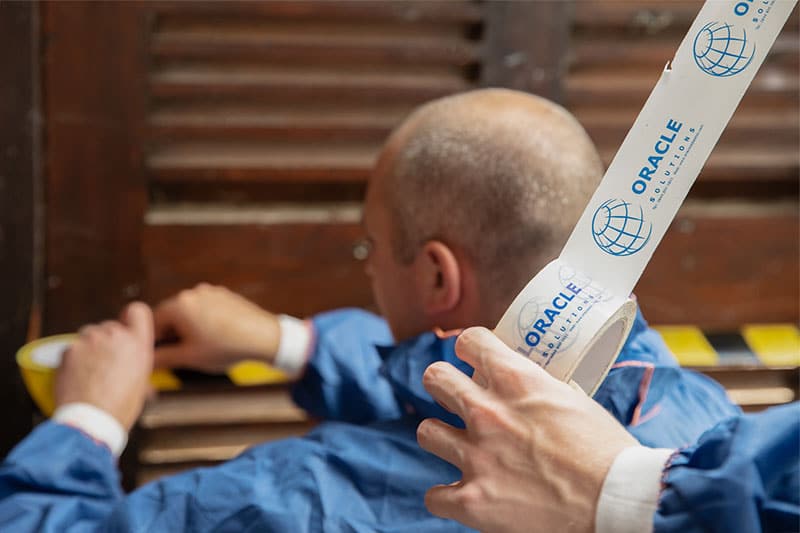What is classed as non-licensed asbestos work in the UK?
Non-licensed asbestos work in the UK is any type of asbestos-related project that does not require a licence. Typically, non-licensed work is less risky than licensed work.
However, even with non-licensed asbestos work, there are safety and legal protocols to follow. For example, you need to dispose of the asbestos safely to avoid further contamination.
It’s important to understand the type of asbestos work that’s considered non-licensed in the UK. This way, you won’t mistakenly carry out work that requires a licence. This could potentially be dangerous to you and anyone on the premises. It could also result in legal penalties, like high fines.
In this article, we’ll provide a comprehensive overview of non-licensed asbestos work in the UK.

What constitutes non-licensed asbestos work?
The Health and Safety Executive (HSE) covers the type of asbestos work that doesn’t require a licence. Here’s an overview:
Criteria for non-licensed asbestos work
Broadly, high-risk work typically requires a license and low-risk asbestos work generally does not. In order to not require a licence, the asbestos work must meet the following criteria:
- The work is low-intensity and sporadic. That means the asbestos concentration in the air is no more than 0.6 fibres per cubic centimetre (f/cm3) over 10 minutes.
- The project does not expose workers past the legal limit of 0.1 f/cm3 on average over four hours.
Furthermore, non-licensed asbestos work must meet at least one of the following criteria:
- The task is short and non-continuous, and only non-friable materials are worked with.
- If asbestos will be removed, the asbestos-containing materials (ACMs) are in decent condition and will not be broken up. Furthermore, the fibres must be contained, such as by coating or another type of method.
- The ACMs are in decent condition and are being encapsulated or sealed to prevent future damage.
- The job is to monitor fibre concentration in the air or collect a material sample to have it analysed for asbestos.
Examples of non-licensed asbestos work
Here are just some of the asbestos-related projects that may not require a licence:
- Cleaning an ACM that’s in good condition.
- Drilling into a textured coating ACM to install a fixture.
- Laying cable in an area that includes ACMs.
- Maintenance work to vinyl floor tiles that contain asbestos.
- Removing asbestos cement that doesn’t require breaking it into smaller pieces.
- Repainting asbestos insulating board that’s in good condition.
- Taking a sample of an ACM for analysis.
Detailed information about how to safely carry out different types of non-licensed asbestos work can be found in Asbestos Essentials from the HSE.
Who can conduct non-licensed asbestos work?
While you may not need a licence for certain types of asbestos work, that doesn’t mean that just anybody can take on the project. Every kind of asbestos work in the UK requires the following:
- Risk assessment & Plan of Works
- Appropriate safety controls
- Knowledge, instruction, and training
- Medical surveillance
- Appropriate Insurance
Here’s what’s necessary to learn via training before handling a non-licensed asbestos project:
- How to assess the risk of asbestos exposure
- Safety-focused control measures and work practices
- Selecting and using protective equipment
- Handling asbestos waste
- Emergency procedures in an asbestos exposure event
- Legal requirements relevant to the type of asbestos work
Furthermore, employers need to provide asbestos workers with relevant documentation, including:
- Maintenance records
- Risk assessment for the work
- Plan of work
- Results of air monitoring
- Results of other asbestos testing
Keep in mind that while this will provide an adequate amount of training for non-licensed work, it’s still not enough for licensable work.
Training programs and certifications
Training programs for non-licensed asbestos work can be taken through organisations like the UK Asbestos Training Association (UKATA).
What is the role of asbestos awareness?
Anyone who will be working with asbestos should take asbestos awareness training. However, this isn’t enough for someone who will be working directly with asbestos.
Asbestos awareness gives people the information they need to avoid disturbing ACMs. It doesn’t prepare people to work with ACMs.
Asbestos awareness is important for asbestos workers to have. Note, though, that it must be accompanied by more advanced training.
Risk assessments and control measures
A risk assessment, control measures that minimise exposure, and an asbestos management plan are always required before non-licensed work takes place.
Risk assessments
Before asbestos work begins, a risk assessment must take place, and it has to be done by a competent person. The risk assessment involves and keeps a record of the following:
- Establishing potential risks and who could be impacted
- Identifying what’s needed to remove or reduce the risk
- Implementing the required actions
- Reviewing and updating the risk assessment as needed
The risk assessment has to take place far enough in advance that safety control measures can be instated before the work begins.
Control measures include using exhaust ventilation to keep the air safe, wetting ACMs to limit fibre release, and wearing the proper personal protective equipment (PPE) when working with asbestos. That includes knowing how to use respiratory protective equipment to prevent the inhalation of asbestos fibres.
Notification and reporting
Certain types of non-licensed asbestos work require reporting to the relevant authority. This is called notifiable non-licensed work (NNLW). This may be required when carrying out asbestos tasks like:
- Removing ACMs that have been affected by a fire or flood
- Removing damaged asbestos cement
- Repairing an ACM that has a lot of damage
- Work that could disturb friable asbestos materials
It’s up to you to decide if the asbestos project requires a licence and, if it doesn’t, requires notification. The task, asbestos type, and ACM condition are all factors in whether or not the work is notifiable.
In the case of NNLW, workers must do the following before the work starts:
- Notify the relevant authority that asbestos work is planned
- Identify which areas of the premises will be affected
- Plan for medical exams to take place
- Maintain health records of those involved
Once you’ve sent your notification, you don’t have to wait to hear back from the enforcing authority to begin work. Also, if your asbestos project includes several NNLW tasks, you only have to submit one notification for the entire project.
Medical surveillance for NNLW
Any worker carrying out NNLW must have a medical examination before the work begins. Additionally, if the worker continues to perform NNLW, they must have medical exams a minimum of every three years.
Here are a few more details about NNLW medical surveillance:
- The exam must take place during the workday, and it’s the employer’s expense.
- Only a licensed medical practitioner can perform the exam.
- Chest and lung function must be examined.
- The doctor must give the employer a confirmation certificate that includes the date of the exam. The certificate must be kept in the employer’s records for four years.
You can learn more about this type of medical surveillance here.
Reporting incidents and exposures
In the event of asbestos exposure, you may need to report the incident under the Reporting of Injuries, Diseases and Dangerous Occurrences Regulations 2013 (RIDDOR). We have an article that goes into this topic and explains when an asbestos event should be reported. Read it here.
Final thoughts
Asbestos work that carries a minimal risk of exposure may not require a licence. This means that a non-licensed worker who has adequate asbestos training will be able to perform the work.
Even though this type of asbestos work doesn’t need a licence, legal and safety guidelines still need to be followed, such as receiving appropriate training, creating an asbestos management plan, and possibly reporting the planned work to the authorities.
Certain types of non-licensed asbestos work have to be reported before it begins. Following this protocol means avoiding any legal issues, especially if an unexpected exposure incident occurs.
When it comes to working with asbestos, the main goal is to keep workers, employees, and the public safe. To do that, it’s necessary to undergo training, follow safety guidelines, and stay compliant with the law.

Written by Callum McDonald
Callum McDonald is an expert in asbestos quality management, ensuring rigorous adherence to regulations and high-quality standards in removal projects. His focus on enhancing quality and client satisfaction makes him a crucial asset in safety and compliance within the field. Callum's expertise in technical support and oversight of licensed works underscores his commitment to excellence in asbestos management, providing invaluable guidance to clients in this specialised area.
